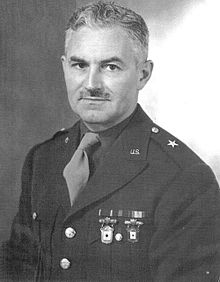Hugh J. Casey
| Hugh John Casey | |
|---|---|

Brigadier General Hugh J. Casey in 1943
|
|
| Nickname(s) | Pat |
| Born |
7 June 1898 Brooklyn, New York |
| Died | 30 August 1981 (aged 83) White River Junction, Vermont |
| Place of burial | Arlington National Cemetery |
| Allegiance |
|
| Service/branch |
|
| Years of service | 1918–1949 |
| Rank |
|
| Service number | 0-9298 |
| Battles/wars | |
| Awards |
Distinguished Service Cross Distinguished Service Medal (2) Silver Star Legion of Merit Bronze Star Distinguished Service Star (Philippines) (2) Honorary Commander of the Order of the British Empire (Australia) Commander, Order of Orange-Nassau (Netherlands) Officer, Légion d'honneur (France) |
| Relations |
Hugh Boyd Casey (son) Frank Butner Clay (son in law) |
| Other work | Chairman, New York City Transit Authority |
Hugh John "Pat" Casey (24 July 1898 – 30 August 1981) was a major general in the United States Army. A 1918 graduate of the U.S. Military Academy at West Point, Casey served in Germany during the Occupation of the Rhineland. He later returned to Germany to attend the Technische Hochschule in Berlin, earning a Doctor of Engineering degree.
As an engineer, Casey prepared a voluminous report on flood control for the Pittsburgh District. He was involved with the design and construction of the Deadman Island Lock and Dam on the Ohio River, and was chief of the Engineering Division at the Passamaquoddy Tidal Power Project, a New Deal public works project. He went to the Philippines in 1937 to advise the government there on hydropower and flood control. In the early part of World War II, he became involved with the enormous wartime construction program. Perhaps his most notable and lasting achievement was his involvement with the design of The Pentagon, the largest office building in the world.
Casey served as General of the Army Douglas MacArthur's chief engineer during the Battle of Bataan, in the jungles and mountains of New Guinea and the Philippines, and during the occupation of Japan. In the Battle of Leyte, he commanded the Army Support Command (ASCOM), which was responsible for all construction and logistics activities in the forward area. He hoped to become Chief of Engineers, but President Harry S. Truman passed him over. Later, Casey worked for Schenley Industries from 1951 until his retirement in 1965, and was chairman of the New York City Transit Authority from 1953 to 1955.
...
Wikipedia
